What’s The Difference Between Enfamil Gentlease and Sensitive?

Enfamil Gentlease aims to provide gentle nutrition for babies with mild digestive sensitivity by using partially hydrolyzed protein, reducing lactose by 80% whereas Enfamil Sensitive, with a 99% lactose reduction and milk protein isolate, targets infants with moderate lactose sensitivity, ensuring easy digestion while maintaining essential nutrients.
The Best One?
The choice between Enfamil Gentlease and Enfamil Sensitive ultimately hinges on your baby’s unique dietary requirements, budget considerations, and the advice of a healthcare professional:
Enfamil Gentlease is a cost-effective solution designed for babies with intact protein allergies and mild lactose sensitivity. In contrast, Enfamil Sensitive caters to infants with moderate lactose sensitivity and offers additional benefits like 2′-FL HMO prebiotic and MFGM. While it may be a pricier option, it could be worth the investment for those seeking these added nutritional elements.
Parent Reviews Comparison:
Let’s delve deeper into the comparison of Enfamil Sensitive and Enfamil Gentlease based on parent reviews:

Enfamil Sensitive:
Positive Reviews:
- Great for Sensitive Tummies: Many parents find Enfamil Sensitive to be a reliable solution for babies with sensitive tummies thanks to its reduction of lactose. It’s often praised for its ability to ease discomfort, reduce gas, and improve overall well-being.
- Helps with Baby’s Gas: One of the standout features of Enfamil Sensitive is its effectiveness in reducing gas. Parents commonly report that their babies experience less gas-related discomfort and are generally happier after making the switch to this formula.
- Easy to Digest: Enfamil Sensitive is known for its gentleness on infants’ stomachs. It’s frequently recommended for babies who struggle with digesting regular formulas due to lactose sensitivity.
- Easy Transition from Breast Milk: Some mothers who initially breastfed their babies find that Enfamil Sensitive provides a smooth transition when they need to introduce formula. This can be reassuring for parents who want to combine breastfeeding and formula feeding.
Negative Reviews:
- Expensive: A common concern among parents is the cost of Enfamil Sensitive. It’s often considered one of the more expensive formula options on the market, which can be a drawback for families on a tight budget.
- Hard to Find: Availability issues can be a drawback for some parents. In certain regions, it may be challenging to find Enfamil Sensitive in stores.
Enfamil Gentlease:
Positive Reviews:
- Good for Gas: Enfamil Gentlease is celebrated for its effectiveness in reducing gas and gastrointestinal discomfort in babies. Many parents find it soothing for their little ones, resulting in less fussiness.
- Good for Soft Stomachs: This formula is well-suited for infants with milder digestive sensitivities. It’s often recommended when a baby has a softer stomach that can’t tolerate regular milk-based formulas.
- Less Colic: Parents have reported a decrease in colic symptoms when using Enfamil Gentlease. This can be a significant relief for both babies and their caregivers.
- Less Spit-up: Reduced instances of spitting up are frequently noted, indicating improved digestion and comfort for babies.
Negative Reviews:
- Bad Taste: While it’s generally well-tolerated, some parents mention that their babies may find the taste of Enfamil Gentlease less appealing compared to other formulas. Taste preferences can vary among infants.
Related: Enfamil Gentlease vs. Similac Sensitive: What is the Difference?
Ingredients Comparison:

Age Range:
Both Enfamil Gentlease and Enfamil Sensitive are suitable for infants from birth to 12 months of age. This versatility makes them convenient choices for parents looking for a formula that can meet their child’s needs throughout the first year of life.
Protein Source:
Enfamil Gentlease derives its protein from partially hydrolyzed nonfat milk and whey protein concentrate solids from soy. The process of partial hydrolysis breaks down proteins into smaller, more easily digestible fragments, which can be gentler on sensitive stomachs.
In contrast, Enfamil Sensitive utilizes a blend of 70% Milk Protein Isolate and 30% whey protein-lipid concentrate, which also includes MFGM (Milk Fat Globule Membrane). The presence of MFGM is noteworthy, as it is believed to have benefits for brain development and immune support.
Whey to Casein Ratio:
While the whey-to-casein ratio is specified for Enfamil Gentlease (60% whey and 40% casein), the ratio for Enfamil Sensitive is not provided. The whey-to-casein ratio can impact the ease of digestion and the composition of proteins in the formula.
Carbohydrate Source:
Enfamil Gentlease: Carbohydrates in this formula come from 20% lactose and 80% corn syrup solids, with the lactose content reduced by 80%. This composition helps make it a suitable option for babies with milder lactose sensitivity.
Enfamil Sensitive: Contains only 1% lactose, with 99% corn syrup solids, and the lactose is significantly reduced by 99%. This is ideal for infants with moderate lactose sensitivity.
Fat Source:
Both formulas Utilize a combination of high oleic sunflower oil, soy oil, and coconut oil as fat sources, and they also include DHA and ARA, which are important for brain and eye development. The use of multiple fat sources is designed to provide a balanced fat profile.
Extra Features:
Enfamil Gentlease: This formula does not specify any additional features beyond its primary ingredients.
Enfamil Sensitive: Includes MFGM (Milk Fat Globule Membrane), an additional component believed to have a positive impact on brain development and the immune system. This makes Enfamil Sensitive stand out as a formula with added benefits for infants.
Related: Similac 360 Total Care Sensitive Vs Enfamil Gentlease
Prebiotics:
Enfamil Gentlease: This formula does not list any prebiotics, which are compounds that promote the growth of beneficial gut bacteria.
Enfamil Sensitive: Contains 2′-FL HMO (2′-Fucosyllactose Human Milk Oligosaccharide), a prebiotic thought to support the growth of beneficial gut bacteria. This is an important feature for promoting a healthy digestive system.
GMO-Free:
Enfamil Gentlease is not specifically labeled as GMO-free, meaning it may contain genetically modified ingredients.
Enfamil Sensitive is GMO-free, indicating that it does not contain genetically modified ingredients. This may be an important consideration for parents who prefer non-GMO products.
Generic Brands:
Enfamil Gentlease has 6 generic or store-brand alternatives, providing parents with more options and potential cost savings.
Enfamil Sensitive Offers 7 generic or store-brand alternatives, also providing flexibility in choosing a cost-effective option. Raed 7 Generic Brand For Enfamil Sensitive.
Source of ARA and DHA:
Both Enfamil Gentlease and Enfamil Sensitive utilize Mortierella alpina oil as the source of ARA and Schizochytrium sp. oil as the source of DHA. These are essential fatty acids that support various aspects of infant development, particularly brain and eye health.
Nutrients Comparison:
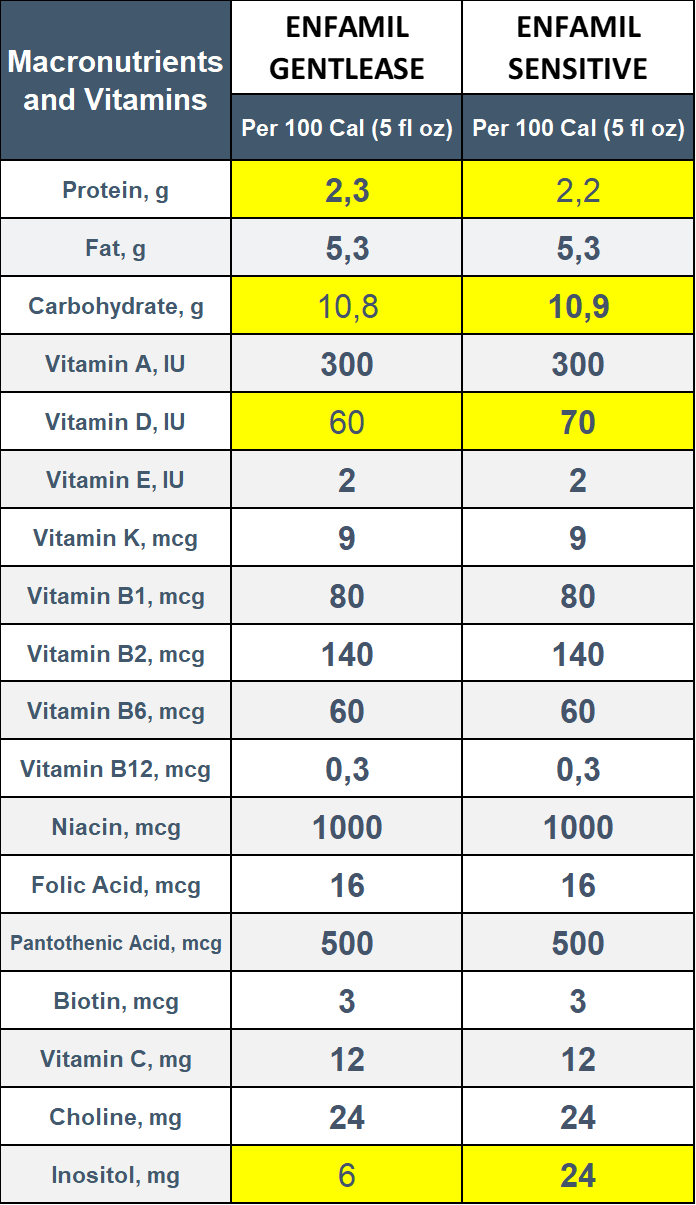
The key differences between Enfamil Gentlease and Enfamil Sensitive formulas in terms of macronutrients and vitamins:
Macronutrients:
Protein Content: Enfamil Gentlease contains 2.3 grams of protein per 100 calories (5 fluid ounces), while Enfamil Sensitive provides slightly less, with 2.2 grams. The difference, although small, may be a factor to consider, especially if your baby has specific protein-related dietary needs. Protein is vital for growth and muscle development in infants.
Carbohydrate Composition: Enfamil Gentlease includes 10.8 grams of carbohydrates, while Enfamil Sensitive has 10.9 grams per 100 calories. These carbohydrates primarily come from lactose and corn syrup solids. The minimal difference may be noteworthy if your baby has specific dietary considerations, but both provide the necessary energy for your baby’s activities and growth.
Vitamins:
Vitamin D Levels: Enfamil Gentlease contains 60 IU of vitamin D per 100 calories, whereas Enfamil Sensitive offers a slightly higher vitamin D content of 70 IU. Vitamin D is crucial for bone health and calcium absorption. The variance in vitamin D levels may be important if your baby needs additional support in this regard.
Other Nutrients:
Inositol Content: Enfamil Gentlease includes 6 mg of inositol, while Enfamil Sensitive contains a notably higher amount of 24 mg. Inositol plays a role in cell membrane structure and function. This difference could be significant if you’re seeking a formula with higher inositol levels for specific health concerns or developmental requirements.
Related: Enfamil Gentlease Vs Enfamil Neuropro Gentlease: What’s The Difference?
Minerals:

The key differences in mineral content between Enfamil Gentlease and Enfamil Sensitive formulas for infants aged 0-12 months:
Calcium (mg):
Enfamil Sensitive offers a slightly higher calcium content at 88 mg. Calcium is crucial for developing and maintaining strong bones and teeth, as well as for various other bodily functions. The difference in calcium levels may be a consideration if your baby requires additional support for bone health.
Phosphorus (mg):
Enfamil Sensitive contains a notably higher phosphorus content at 59 mg. Phosphorus is essential for healthy bone and teeth development, as well as for energy metabolism and cell function.
Sodium (mg):
Enfamil Gentlease contains a higher amount of sodium, 40 mg per 100 calories (5 fluid ounces). Sodium is crucial for maintaining proper fluid balance and nerve function.
Chloride (mg):
Enfamil Sensitive offers a slightly higher chloride content at 67 mg. Chloride is an essential electrolyte, and variations in its levels are generally not a primary consideration for most infants.
Potassium (mg):
Enfamil Sensitive has a slightly higher potassium content at 110 mg. Potassium is vital for maintaining proper electrolyte balance, muscle and nerve function, and overall growth and development. The minimal difference in potassium levels is unlikely to be a primary factor in choosing between these formulas.
Price Comparison:
| ENFAMIL SENSITIVE | ENFAMIL GENTLEASE |
|---|---|
| – | 12.4 oz $21.52 $1.74/oz Buy 12.4 oz |
| 19,5 oz $38,96 2,00 /oz Buy 19.5 oz | 19.9 oz $32.86 $1.65/oz Buy 19.9 oz |
| 29,4 oz $56,96 1,94 /oz Buy 29.4 oz | 27.7 oz $44.96 $1.62/oz Buy 27.7 oz |
| 4.8 of 5.0 758 reviews | 4.8 of 5.0 7096 reviews |
| No RTF | No RTF |
Enfamil Gentlease generally offers a more affordable per-ounce price across multiple package sizes, making it a cost-effective choice for parents. It also has a larger number of customer reviews, suggesting a more significant user base. Both formulas have the same customer rating of 4.8 out of 5.0, indicating high customer satisfaction.
However, Both Enfamil Gentlease and Enfamil Sensitive are not available in a ready-to-feed format.
How to Switch Between Enfamil Gentlease and Enfamil Sensitive?
Switching between Enfamil Gentlease and Enfamil Sensitive formulas can be done gradually and under the guidance of a healthcare professional, typically your baby’s pediatrician. Here are the general steps to consider when making the switch:
- Consult Your Pediatrician: Before making any changes, consult with your baby’s pediatrician. They can evaluate your baby’s specific needs and provide recommendations for the transition.
- Understand the Formulas: Know the differences between Enfamil Gentlease and Enfamil Sensitive, including their ingredients, nutritional content, and suitability for different dietary requirements.
- Start Gradually: A gradual transition is recommended to help your baby’s digestive system adapt to the new formula. Begin by mixing a small amount of the new formula with the old one. For example, you might start with 25% of the new formula and 75% of the old formula.
- Monitor Your Baby: Pay close attention to how your baby responds to the new formula. Look for any signs of discomfort, allergies, or digestive issues. Keep a record of your baby’s feeding patterns and any changes in behavior.
- Increase the New Formula: Over a period of several days to a week, gradually increase the proportion of the new formula while reducing the old formula. For example, you can switch to a 50-50 mix, then 75% new formula, and eventually 100% of the new formula.
- Observe Your Baby’s Reaction: Continue to monitor your baby for any adverse reactions or sensitivities. If you notice any concerning symptoms, consult your pediatrician immediately.
- Maintain Consistency: Once you’ve successfully transitioned to the new formula, maintain consistency with feeding routines to ensure your baby’s digestive system stabilizes.
Remember, each baby is unique, and their tolerance to formula changes can vary. It’s essential to work closely with your pediatrician to determine the best approach for your baby’s specific needs.

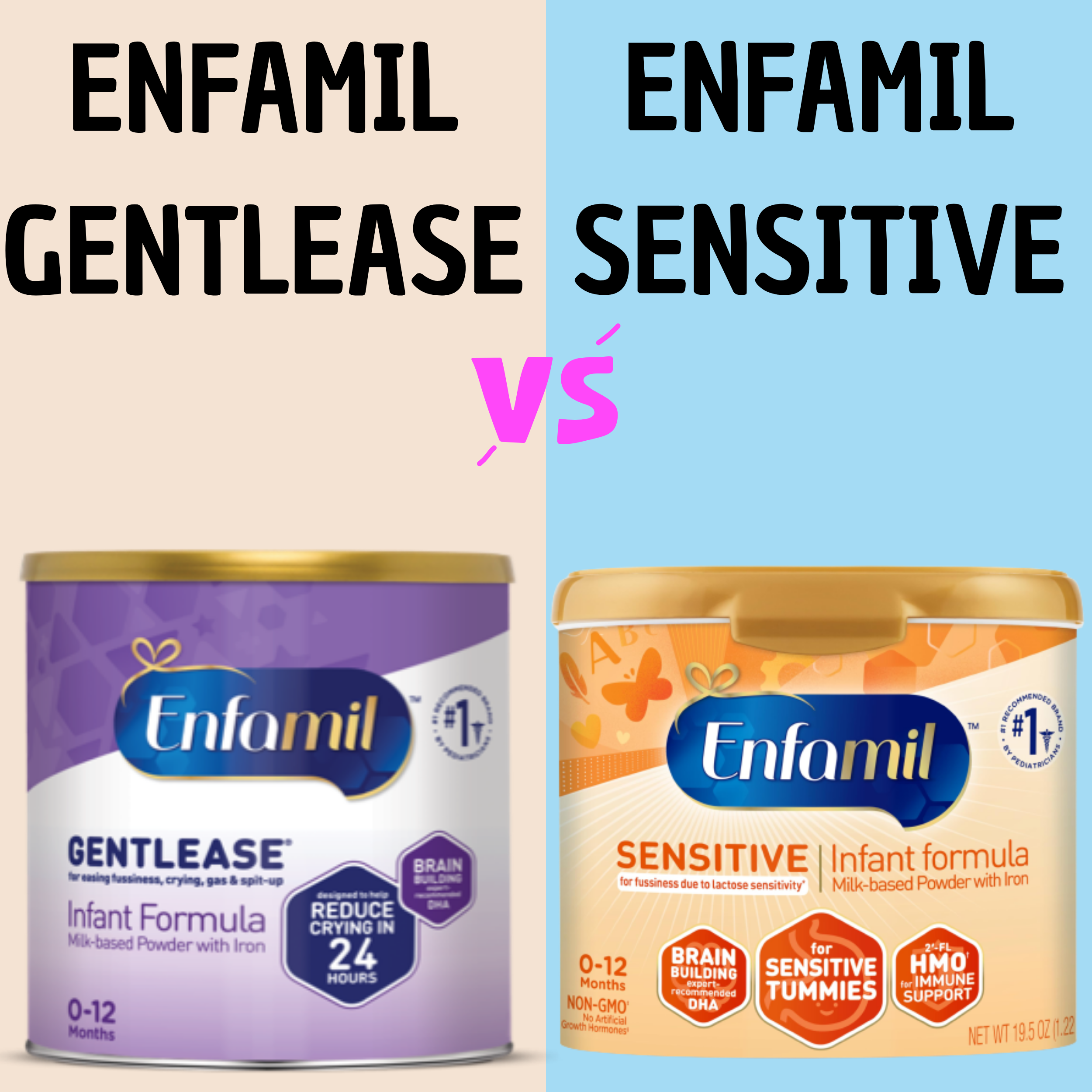

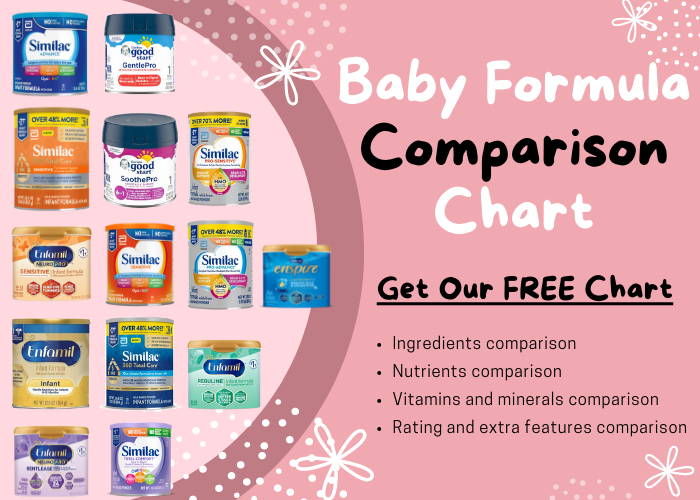


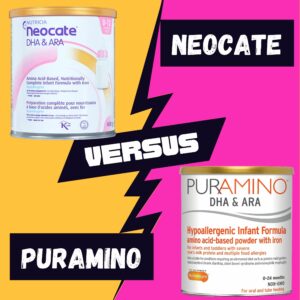
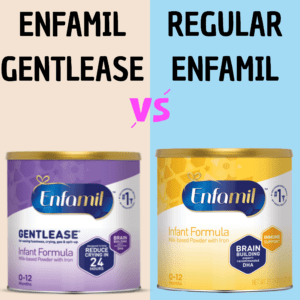
thank you its really nice
neutral thank you its really nice
its yes of course neutral thank you its really nice